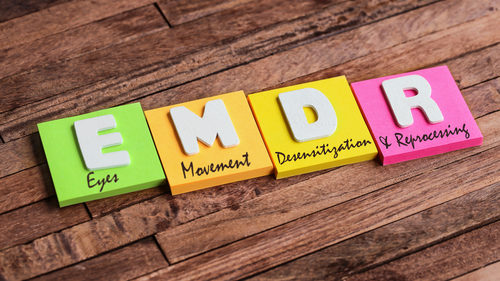The clinical term for drug addiction is substance use disorder. Substance use disorder is listed in the Diagnostic and Statistical Manual of Mental Disorders, Fifth Edition (DSM-5) as a chronic brain disorder. It is characterized by compulsively engaging in rewarding stimuli (e.g. abusing drugs) without regard for consequence. An individual that struggles with addiction will prioritize satisfying his or her drug cravings above all else. Often, this does not only lead to developing a slew of adverse physical consequences, but can also negatively affect one’s relationships, finances, and could lead to legal complications. Substance use disorder is not developed instantaneously, nor does one’s recovery from addiction occur immediately. Every individual is different and will have nuanced needs when it comes to recovering from substance abuse and/ or addiction.
What Is EMDR?
Psychologist Francine Shapiro developed Eye Movement Desensitization and Reprocessing (EMDR) therapy in 1987. According to the EMDR Research Foundation, “EMDR is an integrative psychotherapy approach that has been extensively researched and proven effective for the treatment of trauma. EMDR therapy includes a set of standardized protocols that incorporate elements from many different treatment approaches. To date, EMDR has helped millions of people of all ages relieve many types of psychological stress.” Though it was initially developed as a means to treat individuals suffering from anxiety, posttraumatic stress disorder (PTSD), panic and/ or trauma, research has indicated that it has since become an effective means of treatment for individuals diagnosed with substance use disorder. EMDR incorporates a variety of principals from other therapeutic modalities, including behavioral therapy and cognitive behavioral therapy (CBT).
How Does It Work?
This therapeutic method is based on the notion that physiological symptoms occur as a result of trauma or challenging experiences overwhelming the brain’s natural ability to heal. EMDR is comprised of phases, which include:
- Initial history discovery and treatment planning
- Preparation
- Assessment
- Desensitization
- Installation
- Body scan
- Closure
- Reevaluation
While in the presence of a mental health professional and in a safe and controlled environment, EMDR therapy facilitates the healing process through bilateral stimulation where the individual can revisit the experienced trauma and learn to re-process and reintegrate it in a way that is both healthy and disarming, alleviating physiological stress. A typical EMDR session lasts between sixty to ninety minutes long.
For Information and Support
If you are concerned for yourself or a loved one in regards to substance abuse and/ or addiction we recommend reaching out for help as soon as possible. If left untreated, substance abuse can result in long lasting and potentially life-threatening consequences. Keep in mind: you are not alone! There is an entire network of professionals that are available to help and support you and your loved one throughout the recovery process. The earlier you seek support, the sooner your loved one can return to a happy, healthy, and fulfilling life.
Please do not hesitate to reach out with any questions regarding our specific program at Haven House Addiction Treatment and/ or general substance abuse and/ or addiction treatment related information. Our highly trained staff is readily available to discuss how we might best be able to help you and your loved one. We can be reached by phone at 424-258-6792. You are also welcome to contact anytime us via email at admissions@hhtxc.com.



